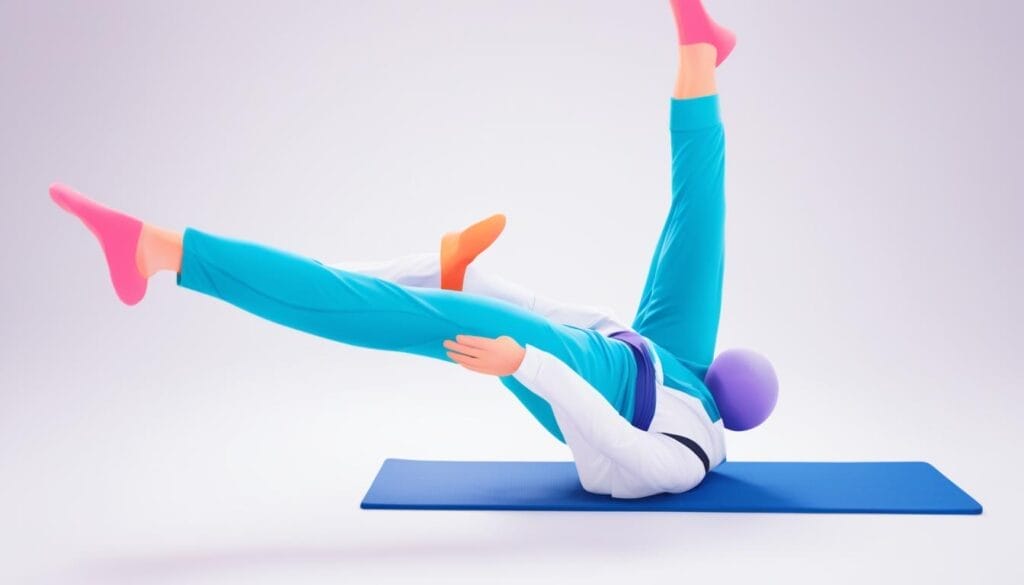Ever feel like you’re going against the current, struggling to find your swim rhythm? If so, you’re not alone. Many of us passionate about swimming hit this hurdle. Flexibility for swimmers is a big challenge, and overcoming it is key.
Flexibility is vital for our swimming. It helps us swim gracefully and efficiently, moving through water easier. This means we reduce drag and increase speed. But, it’s not just about speed. It’s about feeling free, exploring full motion, and reaching our best.
I want to give you some essential advice on boosting flexibility for swimmers. These tips will be useful whether you’ve just started or are already a pro. They are ways to enhance your swimming and push your abilities further.
Key Takeaways:
- Flexibility is crucial for swimmers to improve technique and performance.
- Stretching after swimming and as a separate session at home is recommended.
- Shoulder mobility and ankle flexibility are two significant areas that need improvement for triathletes.
- Sitting for long periods can limit flexibility and range of motion.
- Various mobility exercises and stretches can help improve flexibility and streamline your swimming.
The Importance of Flexibility for Swimmers
Swimmers need to be flexible to do well in the water. A good range of motion helps with stronger muscle use. This means more powerful movements and less resistance, making swimmers faster.
Stretching is key for flexibility and avoiding injuries. It gets the muscles ready by warming them up and relaxing them after. It’s important for swimmers to stretch their shoulders and ankles well because they use these a lot.
It’s vital to stretch correctly to prevent harm. Don’t stretch too hard. Blend static (still) and dynamic (moving) stretches for the best results.
Static stretching means holding a position for a time, and dynamic is moving while stretching. Swimmers benefit from doing both.
Yoga and foam rolling are great for flexibility. They improve overall muscle strength and movement too. Including these in routine will help swimmers do their best and avoid getting hurt.
The Benefits of Flexibility For Swimmers
- Enhanced range of motion
- Increased muscle force generation
- Improved swimming technique
- Reduced drag and increased speed
- Prevention of injuries
Swim Flexibility Exercises
| Exercise | Description |
|---|---|
| Shoulder Stretch | Raises the arm and gently pulls it across the chest, stretching the shoulder muscles. |
| Ankle Mobility Drill | Involves moving the ankle in various directions, improving ankle flexibility for better kick mechanics. |
| Quadriceps Stretch | Stretches the front of the thigh, helping to loosen the leg muscles. |
| Hamstring Stretch | Involves bending at the hips and reaching towards the toes, stretching the back of the thighs. |
| Yoga Cat-Camel Pose | Stretches the entire length of the spine, improving mobility in the back and core. |
Essential Stretches for Swimmers
It’s important for swimmers to be flexible. Flexibility helps with movement and reduces stiffness. This makes you perform better in the water. Let’s look at some vital stretches for swimmers:
1. Arm swings
Arm swings warm up your shoulders. Stand with feet apart. Swing arms back and forth. This gets your shoulders ready for swimming.
2. Leg swings
Leg swings prepare the hips and legs. Stand by a wall for balance. Swing one leg, then the other. This stretch makes your legs flexible, helping your swimming.
3. Ankle circles
Good kicking needs flexible ankles. Sit on a chair, then lift one leg. Move your ankle in circles. Repeat with the other leg. It makes your ankles more flexible.
4. Quadruped T-spine rotation
This stretch is for your upper back, neck, and shoulders. Start on all fours. Move one hand behind your head and twist. Then do the same on the other side. It makes your upper body flexible for swimming.
5. Trunk rotation with leg crossover
This stretch boosts your turning power in water. Lie down and turn your knees to the side. This relaxes your lower back and hips, helping you swim better.
6. Kneeling hip flexor stretch
This is good for your belly and hip muscles. Kneel and push your hips forward. Hold and switch sides. It makes your hips more flexible for swimming.
7. Doorway pec stretch
This stretch helps if your chest feels tight from swimming. Stand in a doorway and push your chest forward. Then switch sides. It makes moving your arms in water easier.
8. Lat stretch
The lat stretch is for your back and shoulders. Stand straight and lean. You should feel a stretch. This helps with different swimming moves.

| Stretch | Description |
|---|---|
| Arm Swings | Dynamic upper body stretches that improve range of motion and muscle activation. |
| Leg Swings | Loosens up the hips and legs, improving mobility and reducing stiffness. |
| Ankle Circles | Important for increasing ankle flexibility and enhancing kicking ability. |
| Quadruped T-spine Rotation | Stretches the upper back, neck, and shoulders, relieving tension and stiffness. |
| Trunk Rotation with Leg Crossover | Opens up the hips and lower back, improving rotational power in the water. |
| Kneeling Hip Flexor Stretch | Benefits swimmers by maintaining and improving mobility in the pelvis and hips. |
| Doorway Pec Stretch | Targets the chest muscles to alleviate tightness caused by swimming. |
| Lat Stretch | Maintains flexibility in the back and shoulders, enhancing swimming technique. |
Tips for Effective Stretching
Stretching is very important for swimmers to boost flexibility. It’s key before and after swimming. Dynamic and static stretches make your body perform better and lower injury risks. Here’s how to make your stretching work:
1. Dynamic Stretches for Pre-Swim Warm-up
Getting your body warm before swimming is vital. Use dynamic stretches. They involve moving like you do in the water. This gets your muscles and joints ready. Try arm swings, leg swings, and ankle rotations. Focus on areas swimmers use, like the quads, hamstrings, and shoulders.
2. Static Stretches for Post-Swim Cool-down
After swimming, help your muscles relax with static stretches. These involve holding a stretch. It helps to loosen up your muscles and boost flexibility. Aim at muscle groups swimmers use, such as shoulders and hips. Do shoulder, hip flexor, and chest stretches.
3. Avoid Overstretching
Flexibility is great, but don’t overdo it. Aim for a stretch where you feel it but not pain. Pushing too hard can cause injuries. Remember, getting more flexible takes time. Listen to your body and be patient.
4. Complement with Yoga and Foam Rolling
Yoga and foam rolling can enhance your flexibility and mobility. Yoga helps with muscle strength and balance. Foam rolling releases muscle tension. These add to your stretches’ benefits and help you do better in water.
| Dynamic Stretches | Static Stretches |
|---|---|
| Arm swings | Shoulder stretches |
| Leg swings | Hip flexor stretches |
| Ankle rotations | Chest stretches |
| Tricep stretches |
Use these tips for better flexibility, technique, and fewer injuries. Keep stretching often and you’ll reach your swimming goals.
Summing Up Flexibility For Swimmers
Working on flexibility helps swimmers get better and avoid injuries. They need to use proper stretching methods and routines. This makes it easier for them to move and use their muscles right.
Before swimming, it’s good to do dynamic stretches. This helps your body get ready and your blood flow better. After swimming, static stretches help your muscles chill out and stretch.
Swimmers should stretch the parts they use a lot, like shoulders, hips, and ankles. Doing things like yoga and rolling on foam can also make you more flexible.
Keep stretching to get better at swimming and reach your top level. Flexibility is a key, so don’t forget to stretch and enjoy swimming more!
FAQ
Why is flexibility important for swimmers?
Flexibility for swimmers is key to boost their skills and how they perform in water. Being flexible means they can move their bodies more, giving them power. This power helps them swim smoothly and faster.
When should swimmers stretch?
Swimmers should stretch after their swim to stop muscles from getting tight. They should also have a different stretching time at home. Avoid stretching before swimming because it won’t prevent injuries and might lower their performance.
What are the areas that need improvement for triathlon swimmers?
Triathletes often struggle with technical issues like not being flexible enough or not moving well. They need to work on their shoulder and ankle flexibility. Flexible shoulders are key for the right swimming position. Good ankle flexibility helps their kicking and push through the water.
How does flexibility impact streamlining in swimming?
Being streamlined is important for swimming well and moving through water efficiently. Not being flexible enough can come from sitting too much. But, becoming more flexible with the right exercises can make swimmers more streamlined. This means they can perform better.
What are the potential benefits of stretching for swimmers?
Stretching makes swimmers more flexible, allowing them to use more muscle power. Better flexibility means moving easily and swiftly in the water. It also cuts down on resistance, making them go faster. Plus, it warms up and cools down their muscles, dodging injuries.
Which stretches should swimmers focus on?
Swims should do stretches that work on their shoulders and ankles. Quadruped T-spine rotations are good for the upper body. They lessen stiffness. Trunk rotations with leg crossovers work on the lower back, helping with twists in the water. Kneeling hip flexor stretches keep hips mobile. Doorway pec and lat stretches keep the chest and back flexible.
What types of stretches should swimmers incorporate into their routine?
Swimmers need both dynamic and static stretches in their routines. Dynamic ones, like arm and leg swings, should be done before the swim to get muscles ready. Static stretches, done after, help muscles relax and stretch out further.
Can yoga and foam rolling help improve flexibility in swimmers?
Yoga and foam rolling are great additions for swimmer flexibility. They can make standard stretches more effective and boost motion range and muscle use.
How often should swimmers stretch?
Swimmers must stretch often to become more flexible and skilled while reducing injury risks. A few stretching sessions weekly can do a lot for their performance.
Can overstretching be harmful to swimmers?
Overstretching is indeed risky, especially for knees and hips. Swimmers should avoid too much, ensuring they stretch safely and within their body’s natural limits.
Which muscle groups should swimmers focus on when stretching?
Swimmers need to care for muscles important in swimming, like quads, hamstrings, hips, chest, shoulders, and triceps. Stretching these parts betters their flexibility and how well they swim.
Source Links
Share Me:
READY TO UNLEASH
YOUR BEST SELF?
Click “Sign Me Up!” And Start Your Fitness Transformation!





